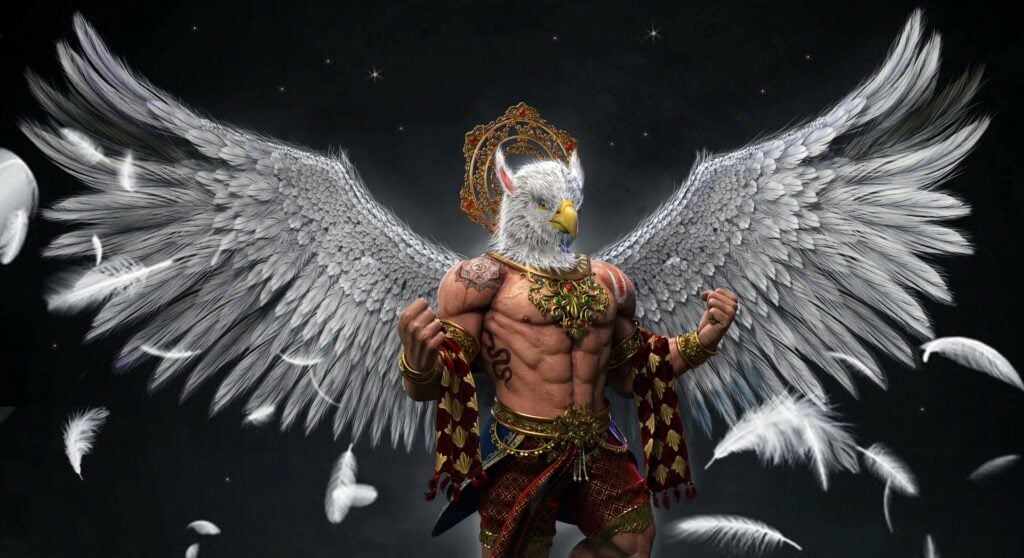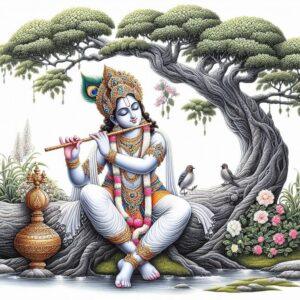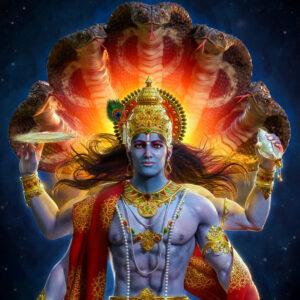
Garuda, a prominent figure in Hindu mythology, plays a significant role as the mount (vahana) of Lord Vishnu, one of the principal deities. In Indian art, Garuda has evolved over time from a bird-like form to one that possesses more human characteristics, while retaining his wings. He is often depicted on Lord Vishnu’s banner and symbolizes birth, heaven, and the enemy of all snakes. Garuda is also seen as a symbol of power, courage, and unwavering loyalty in Hindu mythology.
According to Hindu texts, Lord Garuda is described as having several distinct physical characteristics. He is emerald in color and has the beak of a kite. His eyes are roundish, and he possesses golden wings. Garuda is depicted anthropomorphically with wings and hawklike features. Additionally, he has four arms, and his breast, knees, and legs resemble those of a kite. Garuda is also described as being adorned with a crown on his head and believed to have a gigantic form large enough to block out the Sun God, Surya Devata.
The relationship between Garuda and Lord Vishnu showcases a strong bond between the divine bird and the deity, highlighting their power and mutual respect. Garuda is considered the divine carrier or vehicle of Lord Vishnu, although Vishnu can travel instantly by divine thought and does not necessarily need a mount. Throughout Hindu scriptures and tales, the connection and respect between Garuda and Lord Vishnu are evident in their mutual understanding and power, as seen in various mythological narratives.
In Hindu culture, Lord Garuda is associated with various symbols and attributes. Throughout the Mahabharata, Garuda is invoked as a symbol of impetuous violent force, speed, and martial prowess. He is revered as a divine creature and a loyal devotee of Lord Vishnu. Garuda also holds significant importance in Hinduism and is seen as a symbol of power, courage, and unshakable loyalty. Additionally, Garuda is known as “the devourer” and is popular in both Hindu and Buddhist mythology, where he is seen as the mythical “Lord of Birds.”
Despite being primarily known as the mount of Lord Vishnu, there are no widely known popular stories or legends specifically featuring Lord Garuda or Krishna defeating Garuda in Hindu mythology. However, in Hindu lore, Garuda symbolizes heavenly power and is seen as a representation of virtue, hope, and rebirth, while also embodying a darker side.
Commonly Asked Questions about Lord Garuda
Q1: What is Lord Garuda’s significance and role in Hindu mythology?
A: Lord Garuda is known as the vehicle (vahana) of Lord Vishnu and is often depicted on the god’s banner. He symbolizes birth and heaven and is considered the enemy of all snakes. Garuda also represents power, courage, and unwavering loyalty in Hindu mythology.
Q2: How is Lord Garuda described in Hindu texts?
A: Lord Garuda is described as emerald in color with the beak of a kite, roundish eyes, golden wings, and four arms. His breast, knees, and legs resemble those of a kite. Garuda is depicted anthropomorphically with wings and hawklike features.
Q3: What is the relationship between Lord Garuda and Lord Vishnu?
A: Lord Garuda is primarily depicted as the mount (vahana) of Lord Vishnu, showcasing a strong bond between the divine bird and the deity. Garuda is considered the divine carrier or vehicle of Vishnu, emphasizing their power and mutual respect.
Q4: What symbols and attributes are associated with Lord Garuda in Hindu culture?
A: Throughout the Mahabharata, Garuda is invoked as a symbol of impetuous violent force, speed, and martial prowess. He is associated with various colors representing different elements. Garuda is revered as a divine creature and a loyal devotee of Lord Vishnu, symbolizing power, courage, and unshakable loyalty.
Q5: Are there any popular stories or legends featuring Lord Garuda in Hindu mythology?
A: While Lord Garuda is primarily known as the mount of Lord Vishnu, there are no widely known popular stories or legends specifically featuring him or Krishna defeating Garuda in Hindu mythology. However, Garuda symbolizes heavenly power and is seen as a representation of virtue, hope, and rebirth, as well as embodying a darker side.


